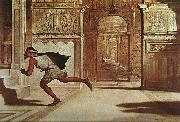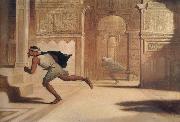
|
William Rimmer
|
|||
|
|
|||
| 1816-1879 William Rimmer Gallery William Rimmer (20 February 1816?C20 August 1879) was an American artist born in Liverpool, England. He was the son of a French refugee, who emigrated to Nova Scotia, where he was joined by his wife and child in 1818, and who in 1826 moved to Boston, where he earned a living as a shoemaker. The son learned the father's trade; at fifteen became a draughtsman and sign-painter; then worked for a lithographer; opened a studio and painted some ecclesiastical pictures. In 1840 Rimmer made a tour of New England painting portraits, he lived in Randolph, Massachusetts, in 1845-1855 as a shoemaker, for the last years of the decade practising medicine; practised in East Chelsea, Massachusetts and received a diploma from the Suffolk County Medical Society and in 1855 removed to East Milton, Massachusetts where he supplemented his income by carving busts from blocks of granite. In 1860 Rimmer made his head of St. Stephen and in 1861 his Falling Gladiator. Rimmer's sculptures, except those mentioned and The Fighting Lions, A Dying Centaur, and a statue of Alexander Hamilton (made in 1865 for the city of Boston), were soon destroyed. He worked in clay, not modelling but building up and chiselling; almost always without models or preliminary sketches; and always under technical disadvantages and in great haste; but his sculpture is anatomically remarkable and has an early Greek simplicity and strength. Rimmer published Elements of Design (1864) and Art Anatomy (1877), but his great work was in the classroom, where his lectures were illustrated with blackboard sketches. Rimmer's most famous work, though not normally associated with him, is Evening: Fall of Day. This paint-on-canvas portrays Apollo, and a modified version was used by Swan Song Records, the recording label founded in 1974 by English rock group Led Zeppelin, in their label art. It is often mistaken to be a picture of Icarus, Lucifer, Satan, or Daedalus | |||
|
|
|||
|
Flight and Pursuit William Rimmer1.jpg Painting ID:: 4327 |
1872 Museum of Fine Arts, Boston | ||
|
|
|||
|
William Rimmer
|
|||
|
|
|||
| 1816-1879 William Rimmer Gallery William Rimmer (20 February 1816?C20 August 1879) was an American artist born in Liverpool, England. He was the son of a French refugee, who emigrated to Nova Scotia, where he was joined by his wife and child in 1818, and who in 1826 moved to Boston, where he earned a living as a shoemaker. The son learned the father's trade; at fifteen became a draughtsman and sign-painter; then worked for a lithographer; opened a studio and painted some ecclesiastical pictures. In 1840 Rimmer made a tour of New England painting portraits, he lived in Randolph, Massachusetts, in 1845-1855 as a shoemaker, for the last years of the decade practising medicine; practised in East Chelsea, Massachusetts and received a diploma from the Suffolk County Medical Society and in 1855 removed to East Milton, Massachusetts where he supplemented his income by carving busts from blocks of granite. In 1860 Rimmer made his head of St. Stephen and in 1861 his Falling Gladiator. Rimmer's sculptures, except those mentioned and The Fighting Lions, A Dying Centaur, and a statue of Alexander Hamilton (made in 1865 for the city of Boston), were soon destroyed. He worked in clay, not modelling but building up and chiselling; almost always without models or preliminary sketches; and always under technical disadvantages and in great haste; but his sculpture is anatomically remarkable and has an early Greek simplicity and strength. Rimmer published Elements of Design (1864) and Art Anatomy (1877), but his great work was in the classroom, where his lectures were illustrated with blackboard sketches. Rimmer's most famous work, though not normally associated with him, is Evening: Fall of Day. This paint-on-canvas portrays Apollo, and a modified version was used by Swan Song Records, the recording label founded in 1974 by English rock group Led Zeppelin, in their label art. It is often mistaken to be a picture of Icarus, Lucifer, Satan, or Daedalus | |||
|
|
|||
|
Flight and Pursuit new4/William Rimmer-237668.jpg Painting ID:: 32006 |
mk77 1872 Oil on canvas 18x26 1/4in | ||
|
|
|||
|
Also Buy::. For Following Paintings / Artists / Products, Please Use Our Search Online: |









